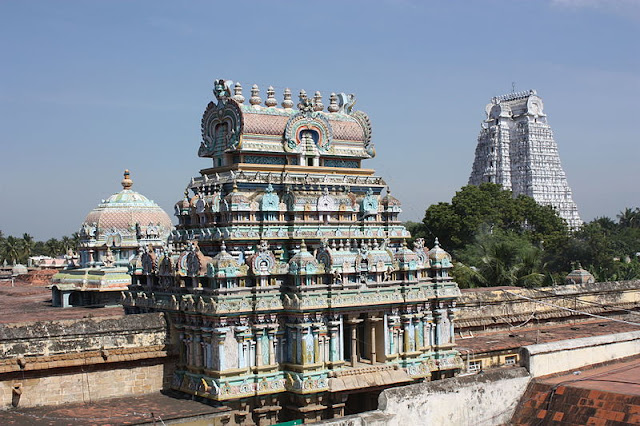Ranganathaswamy Temple, Srirangam – Gopurams (Towers)
Ranganatha, the largest temple complex in Tamil Nadu, measures 950m by 816m (about a half-mile square) along its outer perimeter. It consists of seven nested enclosures (plan), whose walls are pierced by towered gates (gopurams) along the four cardinal axes leading from the shrine. Visitors approach from the south and the shrine faces in this direction. The temple's outer three enclosures contain an entire town, with streets, houses, and shops. The inner four enclosures define the religious zone. The temple is dedicated to Vishnu Ranganatha (i.e., Vishnu sleeping on the cosmic serpent).
The gopurams decrease in size as one approach the central area of the temple. This one is from the second outer enclosure. Ranganatha temple was founded by the Cholas. After an initial growth spurt, it was sacked in the early 1300s by invading Muslims from Delhi. Restored by the Vijayanagara rulers, the temple enjoyed its greatest prosperity under the Nayakas in the 16th and 17th centuries. Its gopurams date mostly from this period, although some (as on the previous page) were only started then, and completed later. The Karthikai gopura is housed in the third enclosure of the Sri Ranganathaswamy Temple.
Gopurams, like the temple towers themselves, symbolize sacred mountains, the habitations of the gods. Architectural forms on the roof fit naturally into this scheme, representing palaces, pavilions, and temples where gods and heroes can disport and display themselves.
There are 21 gopurams (tower gateways), among which the towering 236-feet Rajagopuram (shrine of the main gateway) is the tallest temple tower in Asia until the Rajagopuram of temple Murudeshwara was built by R. N. Shetty . There are totally 21 Gopurams (temple towers) in this temple and its weight is about 24,880 tons.
The 73m high 13- tiered Rajagopuram was built in 1987 by Mutt and dominates the landscape for miles around, while the remaining 20 gopurams were built between the 14th and 17th centuries. The gopurams have pronounced projections in the middle of the long sides, generally with openings on each of the successive levels.
The Vellai gopura (white tower) on the east side of the fourth enclosure has a steep pyramidal superstructure that reaches a height of almost 44m. This tall gopura, on a Vijayanagara-period base, straddles the fourth enclosure wall. The base of most gopurams was constructed of hard stone for stability. The superstructure, made of brick and plaster for lighter weight, could be added later, resources permitting, and either whitewashed or painted.
Rajagopuram standing atop the main entrance rises from the base area of around 13 cents (around 5720 sq. ft.) and goes up to 237 feet (73 meters) moving up in eleven progressively smaller tiers. The structure of the Rajagopuram remained incomplete at the base ('kalkaram', 17 meters high), for over 400 years.
Started during the reign of Achyuta Deva Raya of Vijayanagar, the construction was given up after the king's death and apparently was not resumed owing to some political preoccupations or crisis. The Rajagopuram (the main gopuram) did not reach its current height of 73 m. until 1987, when the 44th Jeer of Ahobila Mutt initiated the process with the help of philanthropists and others. The whole structure was constructed in a span of eight years.
The Rajagopuram was consecrated on 25 March 1987. The length and breadth at the base of the Rajagopuram is 166 feet and 97 feet, while the length and breadth at the top is 98 feet and 32 feet. Befitting the grandeur dimensions of the structure, every one of the 13 glistening copper 'kalasams' at the top of the tower weighs 135 kg and measures 3.12m (height) by 1.56m (diameter).
The Ranga Vimana over the sanctum sanctorum is shaped in the form of an Om symbol and is plated in gold. The presiding deity Sri Ranganathar is seen reclining on Adisesha, the holy serpent. The Moolavar is seen facing southwards towards Lanka. Images of Vibhishana, Brahma, Hanuman, Garuda, symbols of Vishnu – conch and discus are seen inside the sanctum.
































































